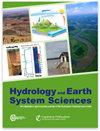airGRteaching:一个用R进行水文建模教学的开源工具
IF 5.8
1区 地球科学
Q1 GEOSCIENCES, MULTIDISCIPLINARY
引用次数: 0
摘要
摘要水文建模是大多数与水有关的研究的核心,特别是在预测灾害、管理水资源和规划适应策略方面。因此,教授水文建模是一件重要但困难的事情。水文建模教学需要合适的软件和教材(练习、项目);然而,尽管目前存在许多水文建模工具,但只有少数适合教学目的。在本文中,我们介绍了airGRteaching包,这是一个开源的R包。可用于airGRteaching的水文模型是GR降雨径流模型,即基于集总处理的模型,允许模拟水流,包括GR4J模型。在这个包中,由于图形用户界面和有限数量的功能,提出了许多水文建模练习,代表了广泛的水文应用。为了方便学生和教师使用,该手册包含了几个描述完整项目的小插图,这些项目可以用来研究各种主题,如河流重建、水文预报和气候变化影响评估。本文章由计算机程序翻译,如有差异,请以英文原文为准。
airGRteaching: an open-source tool for teaching hydrological modeling with R
Abstract. Hydrological modeling is at the core of most studies related to water, especially for anticipating disasters, managing water resources, and planning adaptation strategies. Consequently, teaching hydrological modeling is an important, but difficult, matter. Teaching hydrological modeling requires appropriate software and teaching material (exercises, projects); however, although many hydrological modeling tools exist today, only a few are adapted to teaching purposes. In this article, we present the airGRteaching package, which is an open-source R package. The hydrological models that can be used in airGRteaching are the GR rainfall-runoff models, i.e., lumped processed-based models, allowing streamflows to be simulated, including the GR4J model. In this package, thanks to a graphical user interface and a limited number of functions, numerous hydrological modeling exercises representing a wide range of hydrological applications are proposed. To ease its use by students and teachers, the package contains several vignettes describing complete projects that can be proposed to investigate various topics such as streamflow reconstruction, hydrological forecasting, and assessment of climate change impact.
求助全文
通过发布文献求助,成功后即可免费获取论文全文。
去求助
来源期刊

Hydrology and Earth System Sciences
地学-地球科学综合
CiteScore
10.10
自引率
7.90%
发文量
273
审稿时长
15 months
期刊介绍:
Hydrology and Earth System Sciences (HESS) is a not-for-profit international two-stage open-access journal for the publication of original research in hydrology. HESS encourages and supports fundamental and applied research that advances the understanding of hydrological systems, their role in providing water for ecosystems and society, and the role of the water cycle in the functioning of the Earth system. A multi-disciplinary approach is encouraged that broadens the hydrological perspective and the advancement of hydrological science through integration with other cognate sciences and cross-fertilization across disciplinary boundaries.
 求助内容:
求助内容: 应助结果提醒方式:
应助结果提醒方式:


